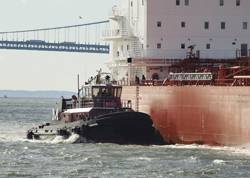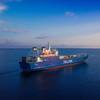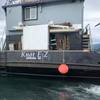Random Roamings within the Moran Fleet
We all appreciated Don Sutherland's celebration of the 150 years of Moran towing (Maritime Reporter & Engineering News, April 2010). It was an exciting collection of vignettes on the life of the company and of its founder, Michael Moran. There were many other aspects of that remarkable company and of its equally remarkable founder that might further inform, if not entertain, the readers of Maritime Reporter.
Rarely has a Moran tug been lost, but during the 1890s one vessel was overcome by heavy weather conditions immediately outside of New York harbor. The company had contracted during this period to tow refuse barges to be dumped in the open sea outside of Sandy Hook. The tug F. W. Vosburgh, built for Michael Moran in 1883 by Peter Magee, of , , was lost at 2 a.m.on 10 March 1895 in a blinding snow storm when she ran upon Romer Shoal, off , while towing a garbage scow. The crew of nine was rescued by the nearby tug Carrie A. Ramsay.
More recently, was the loss of the third Eugene F. Moran. She was a steel-hulled tug of 1905 vintage named Protector when she was acquired by Moran in June 1917. Her life in the fleet was short, for on 8 December 1917 she foundered off ---not far from the site of the F. W. Vosburgh loss. Alas, of the thirteen men aboard at the time, only four were saved.
The naming of the tugs after members of the family was, until recently, a fact that any tugboat admirer could look forward to. From eldest to youngest, Michael's offspring consisted of Thomas E., Richard J., Eugene F., Agnes A., William J., and Joseph H. There were, according to recent research, nine vessels were named for Eugene F., seven for Julia C. ('s wife), six each for "M." (Michael) and Doris, and five each for Marion and Thomas E. Surprisingly, Michael's wife, Maggie, provided the name for only one vessel in the fleet.
The appearance of tugs has, needless to say, changed remarkably over the years, from the gracefully proportioned vessels of the late nineteenth century to the pushboats of today having tower pilot houses. Among the tugs that many thought was a good looking tug was the first Marion Moran, built by Neafie & Levy in 1888. Originally named E. L. Levy, she ran until June 1917 for the Lake Champlain Towing Co. and the Cornell Steamboat Co. Sold at that time to Thomas J. Scully, she was renamed Mary F. Scully, then went to the Neptune Line as , and in the Moran fleet from 1925 to 1948. This vessel was one of the historically significant tugs operating in waters over her sixty-year lifetime. For many years she was an important line-haul tug on the under her original name, and she was a long time member of the Moran fleet.
Since the change in ownership of the company, the tugs continue to be christened with Moran names, but the people so honored contemporaneously are not family members. According to the company website, the current tug Kaye E. Moran honors Kaye E. Barker, wife of corporate officer James R. Barker, for whom the tug James R. Moran was named. It matters not, for the new vessels are nicely named.
Don mentions the fact that the first diesel-propelled tug in the fleet dated from 1923. She was built in 1919 for the U. S. Navy as a unit of a class of forty wooden hulled harbor tugs of a type built in great numbers through World War One. She was named Harbor Tug No. 84 and was powered with a single-cylinder steam engine---which made her what the old timers used to call a "high-pressure boat." Sold to Moran in 1923, she was renamed Eugenia M. Moran and was fitted with a diesel having remarkable cylinders 14½ inches in diameter by 21 inches stroke. She was sold out of the fleet about 1930 and was lost a few years later.
The next diesel vessel was Marie S. Moran, built by Pennsylvania Shipyards, Inc., at Beaumont, Texas in 1936, and fitted with a 550-hp Winton diesel. I recall reading of the vessel in a copy of Diesel Progress of that period. In 1937 came two more tugs from the same builder---Eugenia M. Moran (the second of the name) and Elizabeth W. Moran---powered by 1350-horsepower Wintons. From that point onwards came an enormous fleet of General Motors-powered diesel and diesel-electric tugs. There was a close association between Moran and the GMAC in those early days which undoubtedly contributed to the growth of the diesel fleet.
During World War II, the United States Maritime Commission built a fleet of ocean-going diesel-propelled tugs of their Design V4-M-A1 to provide services to the enormous numbers of vessels in the wartime fleet. The V4 was something more than a tug; she was about 200 feet in length with a beam of 37 feet 6 inches, and propelled by a diesel engine of about 2300 horsepower. No less than forty-nine tugs of this design were built, and all were operated by Moran. The irony of this is that they were propelled by diesels, not General Motors.
Among the late entries into the wooden hulled tugboat world was a fleet of 58 vessels having a length of about 100 ft. built by the United States Shipping Board. A large number of these tugs were based in , and the Moran fleet at one time or another owned no less than twenty-one units of this fleet. Of these, many were acquired with the purchase by Moran of other towing fleets---six tugs from Meseck, six from Amboy Towboats, two from E. E. Barrett, two from Goodwin-Gallagher. Three of the vessels were bought from the Shipping Board by Moran about 1921, while two were purchased from Federal Shipbuilding in 1936 and sold the same day to the Mystic Steamship Company. The last of this fleet owned by Moran was Margaret A. Moran (ex-Edward A. Meseck). She lasted until 1963, when she was out of documentation.
In 1954, the Moran organization acquired the business of the Meseck Towing & Transportation Company and its entire fleet, which consisted almost entirely of steam tugs, ranging from wooden hulled, single-cylinder-engined vessels built by A. C. Brown at Tottenville, Staten Island, through the Shipping Board tugs mentioned above, and culminating in a group of welded steel tugs equipped with Skinner Unaflow engines and built at Newburgh, New York, between 1940 and 1945 by Harry A. Marvel.
The capstone of the Unaflow fleet was C. Hayward Meseck, a 115-footer built in 1945. Originally to have been 135 feet in length for ocean service, she was shortened before construction, keeping the originally specified three-cylinder 25" x 26" engine and watertube boiler---a plant rated at 1500 horsepower, but capable of continuous output of around 2000 horsepower. Her scantlings were extra heavy as built, for the steel had been delivered for the 135-foot vessel.
Moran operated this vessel as Alice M. Moran. After a meeting at the Moran office a year or so after the tug had been sold for scrap, this author, who incidentally had laid her down in the mold loft, spoke with a Moran staff member who stated that scrapping Alice M. Moran was a terrible mistake, and that with her splendid hull, she should have been given a modern diesel engine. Sadly however, this remarkable last vessel built by Harry Marvel was gone.
Finally, there was the side-wheel towboat Belle, mentioned by Don relative to an 1892 photograph. Belle had been built as a passenger steamboat in 1837 and was converted in mid-career to a towboat. She was bought from the Schuyler Towing Line by Michael Moran and Peter Cahill for $7,000, probably just prior to the 1892 view, but she was not in Michael Moran's fleet for a long time. It is this author's surmise that she might have been acquired to start a towing enterprise on the Hudson River, moving a part of that immense fleet of Erie Canal barges from to , perhaps in competition with the Cornell Steamboat Company. That never happened, for Belle was sold to Cornell in 1893, her sale price part of the cost of keeping Michael off the river. Belle was abandoned in 1897, but during her short Moran ownership, the ancient vessel was always referred to by Michael, in his inimitable auld-country accent, as "me Belle."












